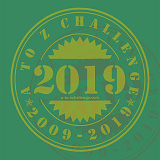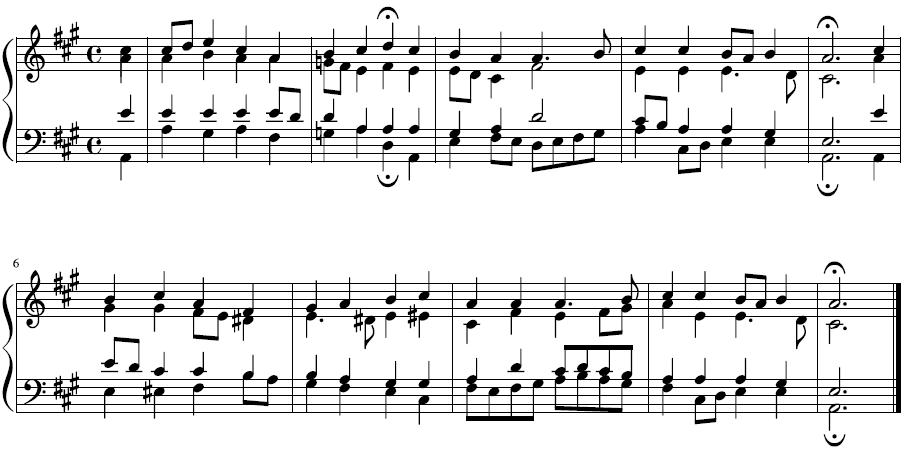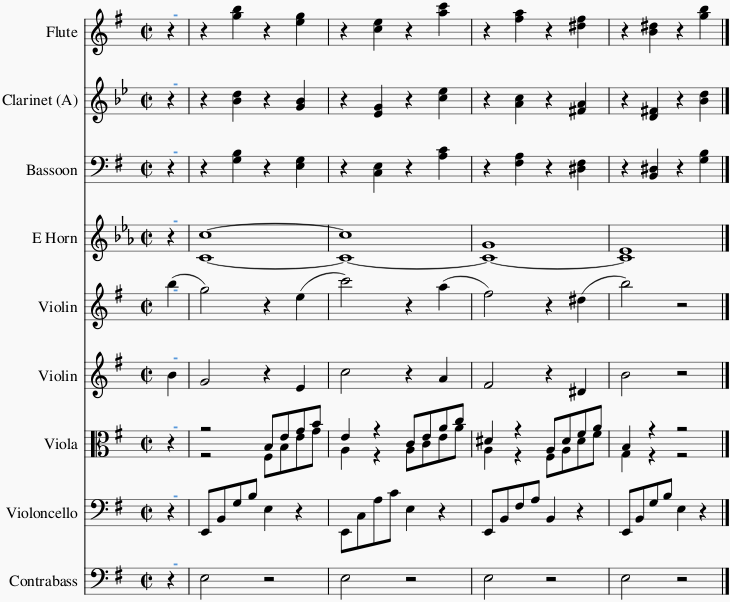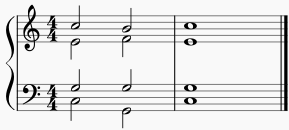I had plans to do the Blogging A-to-Z challenge this year as I've done the last two, but reality intervened. In theory I have more time to write than last year. In fact I didn't have the energy required to plan and start drafting entries mid-March, for obvious reasons.
Things have stabilized since my office closed on the 17th, and I've gotten back into the swing of working from home every day. But I feel like a full 26-post series this month would not rise to my own standards of quality for permanent, information-based writing.
Check out my 2018 A-to-Z posts on C# programming and my 2019 posts on music theory. I'll do it again in 2021—or, possibly, in May.
 Here is the list of topics I wrote about for the 2019 Blogging A-to-Z challenge on the topic of music theory:
Here is the list of topics I wrote about for the 2019 Blogging A-to-Z challenge on the topic of music theory:
I posted all of them on time this year (7am Chicago time, noon UTC) except on April 13th. I'm quite proud of that. Last year I was less diligent.
I hope you've enjoyed the series. I'm looking forward to next April's topic, which I think you'll find timely and informative.
 Today the Blogging A-to-Z challenge comes to a close, and for the fourth time this year, I have to punt.
Today the Blogging A-to-Z challenge comes to a close, and for the fourth time this year, I have to punt.
Search all you want: music theory really doesn't have any important terms starting with Z. So today, I'm going to talk about one of my favorite vocal works: Brahms' opus 103, "Zigeunerlieder" (Gypsy Songs). I performed three songs from the cycle with the Illinois Music Educators Association All-State Honors Chorus in 1987, 100 years after Brahms wrote it. (Yes, back then I was one of the 256 best high-school age singers in the entire state. I am, right now, blowing on my fingernails.)
Enjoy it. As the score scrolls by, see how much of what I discussed this year you recognize. And enjoy it; it's a cool song cycle.
That's it for the A-to-Z challenge this year. Next April, I'll have a timely topic. Before then, I expect to publish my 7,000th blog entry (probably mid-October), take my 100,000th photograph (probably this month), and live my 18,000th day (almost certainly December 17th).
Thanks for reading!
 Our penultimate Blogging A-to-Z challenge post this year features the person in your life most likely to continue learning music theory: you.
Our penultimate Blogging A-to-Z challenge post this year features the person in your life most likely to continue learning music theory: you.
If you like music, go hear it. CDs and downloads are fine, but really you need to go out to hear live music as often as you can. Go hear the symphony; go to a garage band; toss a dollar in a busker's case in the subway. (You never know who might be performing down there.)
And keep learning how music works. This series has only skimmed the surface of music theory. The Web has several excellent sources for more depth: read Open Music Theory, take quizzes at MusicTheory.net, check out the Music Notation Project. Take a class at your local college. (In Chicago, DePaul and Northwestern have excellent music schools.)
Thanks for reading this series. I'll have a post for Z tomorrow, too.
 The Blogging A-to-Z challenge sometimes loses its way when the topic you want to write about doesn't really have anything interesting to say for one of the letters of the alphabet.
The Blogging A-to-Z challenge sometimes loses its way when the topic you want to write about doesn't really have anything interesting to say for one of the letters of the alphabet.
So let it be with X.
Further, it's finally spring in Chicago, so maybe the sunlight and warm weather have made me a little lazy.
To that point, let me just say that the xylophone is a percussion instrument with wood bars that you strike with a mallet to make sounds. Like this:
 Today's Blogging A-to-Z challenge entry examines the physics of music. Specifically, when a musician looks at a note on a page, what tone does she actually produce?
Today's Blogging A-to-Z challenge entry examines the physics of music. Specifically, when a musician looks at a note on a page, what tone does she actually produce?
Most people today have passing familiarity with the piano, which has one key per note. This means the frequency of each note remains the same no matter what key a pianist plays in. If she hits the A above middle C, the piano strings vibrate at 440 Hertz (cycles per second). The A below middle C is 220 Hz, the A below that is 110 Hz, and so on. All of the notes in between have fixed frequencies as well.
This system, dating from about the beginning of the 20th century, is called equal tempering. It has some pretty interesting consequences, first among them that only the octaves are perfectly in tune. Every other interval is slightly out of tune—sometimes in two ways.
Equal tempering is a compromise, driven in part by the popularity of the piano, because they're so hard to tune. Other instruments don't have this limitation, so in some circumstances (i.e., string quartets), you might hear well-tempering instead.
In well-tempered tuning, some intervals actually do retain their proper mathematical relationships. But only some. Well-tempering is another compromise, resulting in different keys having wildly different tone colors. Bach promoted well-tempering with his two-volume set of preludes and fugues called The Well-Tempered Clavier. (Cue the irony that most people today have never heard it played on a well-tempered instrument. I found a good demonstration of the differences between equal- and well-tempering that's worth 12 minutes of your time.)
Before well-tempering, musicians used Pythagorean tempering (based on perfect 5ths) and meantone tempering (imperfect 5ths to get better 3rds).
For more about this topic, Nathan Nokes has a good video about the physics of these earlier tuning systems, with pure-tone examples. Notice how just and Pythagorean temperaments sound out of tune. Except they're not; they're just different.
 We're finally putting together a lot of what I've covered in this year's Blogging A-to-Z challenge. Today I'll touch on voice leading (known as "part writing" in the UK), which describes how individual voices in a composition work separately to create a musical whole.
We're finally putting together a lot of what I've covered in this year's Blogging A-to-Z challenge. Today I'll touch on voice leading (known as "part writing" in the UK), which describes how individual voices in a composition work separately to create a musical whole.
We already talked about counterpoint, in which we saw how two vocal lines interact while moving independently of each other. That's the essence of voice leading. But when you add more voices, the rules become a bit more complex.
Open Music Theory has a good explanation of the problems that voice leading aims to solve:
The “fundamental musical problems” we will address in the study of counterpoint center around the way in which some basic principles of auditory perception and cognition (how the brain perceives and conceptualizes sound) play out in Western musical structure. For example, our brains tend to assume that sounds similar in pitch or timbre come from the same source. Our brains also listen for patterns, and when a new sound continues or completes a previously heard pattern, it assumes that the new sound belongs together with those others. ... These abilities are also what allows music to have the emotional effect that it does on so many people. Whether or not a composer or songwriter is aware of the science and psychology of hearing, a masterful composer mediates and plays with these basic concepts.
In short, voice leading "leads the ear" in service of the music as a whole.
The general rules are:
- Favor small intervals
- Avoid crossing lines
- Avoid parallel fifths and octaves
Here's a simple example that demonstrates how each voice can have its own life and still form a cohesive whole:

So what's going on in there? All four lines have their own melodies (particularly the soprano and tenor lines), I've avoided parallel 5ths and octaves in a couple of tricky spots while still maintaining a decent chord progression, and none of the lines cross—though they do, occasionally, trade notes. Notice the tenor D on the second beat of the 3rd measure followed by the alto D in the next beat.
(There's also a joke buried in there. Play each of the vocal lines separately and you'll find it. The joke explains why there's a bit of clunkiness between the second and third measures.)
But that's just me demonstrating a concept. Here's what a genius does, in the first of his nearly 400 surviving chorales:

(Bonus pdf file.)
 The Blogging A-to-Z challenge entry today starts with a joke: what is the definition of a minor second? Two oboes playing in unison.
The Blogging A-to-Z challenge entry today starts with a joke: what is the definition of a minor second? Two oboes playing in unison.
Sorry, oboes.
We already know what unison means: it's two voices sounding the same note. And earlier I mentioned that different instruments use different clefs. And we've covered key signatures. Now I'm going to tell you a dirt secret of the orchestra: unison sometimes looks like a bunch of completely different notes.
The problem comes from the way that certain brass and woodwind instruments work. Different instruments naturally play in different tunings. For example, if you play a natural scale on a French horn, you're actually playing (usually) an F or Bb scale. So we say that the horn is "in F" or "in B flat." Which leads to the part that string players and singers struggle to understand: music for the French horn is written as if C is F. Or Bb. In other words, horns fall into the class of transposing instruments, because they naturally transpose the notes written on the page.
To illustrate, here is how we write an F major scale played in unison—exactly the same notes—between a viola and a French horn in F:

The viola starts on F, but the horn starts on C. Except that the horn's written C is actually sounds like F.
It gets even crazier when you combine a bunch of instruments that transpose in different keys. Here's the opening of Brahms's Symphony #4 in e minor:

The flute, bassoon, and strings are in C, so when they play the note written as C they actually play a C. The clarinets are in A, so when they play what's written as C out comes an A. The key signature has to change, too; theirs is in C minor, because when they see a C the sound they make is actually E. Opposite issue for the French horns, which Brahms wanted in E: when they play the note written as C (as they do for four bars), they're actually playing G, which is also why their staff is in A minor.
It's all finally coming together, isn't it?
 Today's Blogging A-to-Z challenge post sits right in the middle of everything.
Today's Blogging A-to-Z challenge post sits right in the middle of everything.
The tritone is the interval between the perfect 4th and the perfect 5th. Depending on which direction you're going, it's either an augmented 4th or a diminished 5th. And it's always going somewhere.
In the C major scale, the natural tritone is between F and B (where it's an augmented 4th) or B and F (where it's a diminished 5th). B, remember, is the leading tone in the key of C, so it really, really wants to resolve to C. The F (subdominant) wants to resolve to E (the mediant). Therefore, if you have an augmented 4th, it wants to resolve to a minor 6th (which is also the tonic chord in first inverstion):

And if it's a diminished 5th, it resolves to the major 3rd:

Remember ethnic 6th chords? Tritones all the way down. Even in a basic I-V7-I progression, the V7 has the tonic chord's tritone in it:

The tritone is between the first and second lines from the top. Just as in the very first example on this post.
 The Blogging A-to-Z challenge will get a little funky today as we look at syncopation, which is nothing more than an unexpected rhythm.
The Blogging A-to-Z challenge will get a little funky today as we look at syncopation, which is nothing more than an unexpected rhythm.
Here's a simple example. Take this clunky melody:

Now let's syncopate it a little, by shifting some of the notes off the beat:

Instead of hitting 1, 2, 3, 4, 1, 2, 3, 4, now it hits 1, and, and, and, 2, and, and, 4. It's harder to dance to but more interesting.
More examples? How about Mozart's Symphony #40, third movement:

Or the Rolling Stones? Beethoven? Scott Joplin?
Syncopation is every——where!